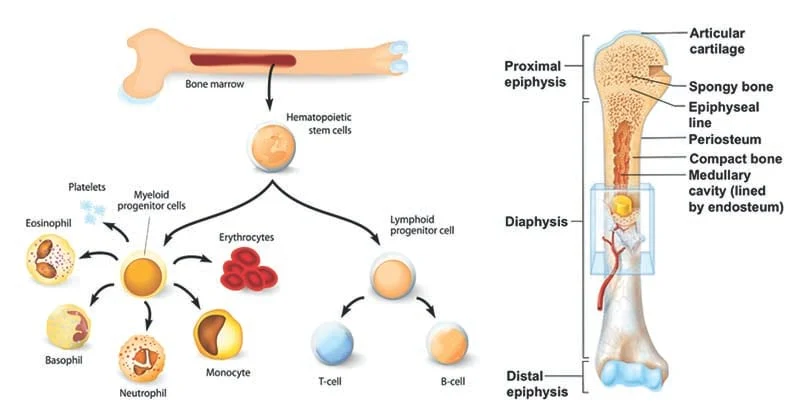
World Bone Marrow Donor Day is celebrated every year on the 3rd Saturday of September all over the world to thank all the blood stem cell donors worldwide. The main objective of celebrating the day is to thank all the stem cell donors, unknown donors family members, and donors who have enlisted on the global registry and waiting to donate. The secondary objective is to raise awareness among the public on the importance of donating stem cells and how important it could be for a patient. Massive awareness campaigns are done to break the myths and wrong information about donating stem cells and the need for more people to enlist in the registry as many patients are still unable to find a perfect match.
This is the soft, spongy tissue inside some of the bones in the body, such as the hip bones and the thigh bones, which makes blood stem cells, i.e., blood-forming cells. It carries immature cells called stem cells. These cells turn into blood cells, including red blood cells, white blood cells, and platelets. The bone marrow makes more than 200 billion blood cells every day. This is vital since blood cells have a limited life span, about 100-120 days in the case of red blood cells. Therefore they need to be replaced continuously, and thus the proper function of the bone marrow is vital for the body.

A bone marrow transplant is a procedure in which the damaged or destroyed bone marrow is replaced by healthy stem cells from the donor. The procedure transplants new stem cells, these cells produce new blood cells and promote the growth of new marrow.
Bone marrow transplants are required when bone marrow is affected due to some disease, making it unable to function properly. In such cases, a bone marrow transplant is the best option for treatment or cure.
The bone marrow of a person may not function due to several diseases such as:
There are two major types of bone transplants:
Autologous Transplants
This is done using the patient's cells. The cells are removed before the patient undergoes any high-dose treatment such as chemotherapy or radiotherapy, and stored in a freezer. After the treatment, the cells are put back into the body. However, this procedure is not always possible as it can be used only when the patient has healthy bone marrow.
Allogeneic Transplants
In this type of transplant, stem cells from the donor are taken to replace the damaged stem cells of the patient. It is imperative that the donor must have a close genetic match, and therefore, most close relatives become donors. Tests are done to check the compatibility between the donor's genes and the patient's genes before the transplant. These transplants have a higher risk of complications, such as Graft versus host disease (GVHD), where the patient's body may see the stem cells as foreign and attack them.
There is another type of transplant, called the umbilical cord blood transplant, which is a type of allogeneic transplant. In this method, stem cells are removed from a newborn baby's umbilical cord right after birth and are stored until they are needed in the future. This method is used since the need for perfect matching is less as umbilical cord blood cells are very immature.
There is another subtype of allogeneic transplant, called a horizontal transplant. This is also called a half-matched or partially matched transplant as the donor is a half-match for the patient. This procedure is followed when the doctors can't find a perfect donor match and decide to use stem cells from donors who are exactly half a match of the patient's DNA. The donors are usually parents or siblings as only they have the chance to half-match the patient's DNA.
The doctors test the blood of the patients to find out the HLA (human leukocyte antigen) type. HLA is a protein, or a marker, based on which doctors look for a prospective donor that matches with the patient's HLA.
Bone marrow cells can be collected in two ways from the donor:
Typically, the hospital stay for marrow donation is from early morning to late afternoon, and sometimes overnight observation in rare cases. The median time to full recovery after a bone marrow donation is 20 days, although this may differ from person to person. Most donors will be able to resume work, college, or other activities within a week.

Some of the possible side effects usually seen after two days of bone marrow transplant according to reports by Be the Match organisation:
People need to get the right idea about bone marrow transplantation. Many people stay away from marrow donation, fearing the side effects and pain, but most of them are nothing but false facts. This is the reason many patients are unable to find a perfect DNA match for their transplant. Thus it is important to build a pool of donors inculcating all the ethnic backgrounds so that we can help them beat the disease. It is especially essential for more donors from racially, and ethnically diverse communities as patients from these communities face a higher risk of finding a perfect match. All it takes is a cheek swab to register as a potential donor and to experience the feeling of saving another life.
Relief & Comfort from pain and other side effects in Your Cancer Journey
For personalized guidance on cancer treatments and complementary therapies, consult our experts at ZenOnco.io or call +91 9930709000